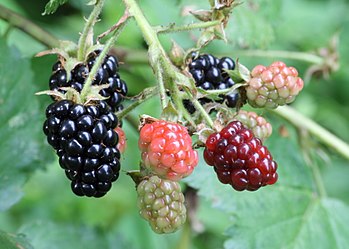THE CHEMICAL COMPOSITION AND NUTRITIONAL VALUE OF BLACKBERRIES GROWING IN THE REPUBLIC OF AZERBAIJAN AND THEIR DEPENDENCE ON THE SPECIES AND REGION OF GROWTH
UDC 634.1/.7: 664.014/.019
Abstract
The work shows the biological and nutritional value of Rubus, which grows in Azerbaijan. It was found that the highest content of sugars is the wild blackberry of the Rubus sanguineus Friv species (8.75±0.19%), while it contains little sucrose, glucose (from 3.10±0.12 to 4.87±0.16%) and fructose (from 3.08±0.28 to 3.40±0.09%) predominate. The content of the mass fraction of organic acids is greater in the species Rubus caucasicus forche (1.94±0.10%) than in the species Rubus caesius and Rubus sanguineus Friv (1.85±0.15 and 1.62±0.12%, respectively). The content of pectin substances in blackberries ranges from 0.26±0.01 to 0.30±0.04%, and the mass fraction of ash from 0.42±0.08 to 0.58±0.11%. In terms of vitamin C content, the species Rubus sanguineus Friv is superior (32.1±1.20 mg/100 g) to the species Rubus caesius and Rubus caucasicus forche (23.76±0.58 mg/100 g and 29.35±0.47 mg/100 g, respectively). In the polyphenol complex of blackberries of the species Rubus sanguineus Friv, Rubus caucasicus forche and Rubus caesius, catechins and anthocyanins are present with a clear predominance of the latter. The results of the studies show that the main indicators of the chemical composition of blackberries depend on the type of raw materials and on the soil-climatic and ecological-geographical conditions of the growing region. The biological and nutritional value of blackberries of various types allows us to consider them as an additional source of physiologically active substances and raw materials for the production of various soft drinks based on them, including tonic energy drinks.
Downloads
Metrics
References
Magerramov M.A. Teplo i elektrofizicheskiye svoystva zhidkikh pishchevykh produktov. [Thermal and electrophysical properties of liquid food products]. Palmarium Academic Publishing, 2012, 429 p. (in Russ.).
Magerramov M.A. Nauchnyye osnovy proizvodstva, teplo i elektrofizicheskiye svoystva plodoovoshchnykh sokov: monografiya. [Scientific foundations of production, heat and electrical properties of fruit and vegetable juices: mono-graph]. Lenkoran', 2020, 321 p. (in Russ.).
Asadov K.S., Asadov A.K. Dikorastushchiye plodovyye rasteniya Azerbaydzhana. [Wild fruit plants of Azerbaijan]. Baku, 2001, 256 p. (in Russ.).
Damirov I.A., Islamova N.A., Karimov Yu.B., Makhmudov R.M. Lekarstvennyye rasteniya Azerbaydzhana. [Medicinal plants of Azerbaijan]. Baku, 1988, 178 p. (in Azer.).
Novruzov E.N., Shamsi Zade L.A. Rastitel'nyye resursy, 1983, vol. 19, no. 3, pp. 366–370. (in Russ.).
Akhmedov A.I. Lechebnyye svoystva s"yedobnykh rasteniy. Monografiya. [Medicinal properties of edible plants. Mon-ograph]. Baku, 2014, 468 p. (in Azer.).
Kolbas N.Yu., Silva M.A., Yeesedr P.L., Reshetnikov V.N. Izvestiya NAN Belarusi, 2012, no. 1, pp. 5–10. (in Russ.).
Gryuner L.A., Kornilov B.B. Vavilovskiy zhurnal genetiki i selektsii, 2020, vol. 24, no. 5, pp. 489–500. DOI: 10.18699/VJ20.641. (in Russ.).
Lee J. Blackberries and Their Hybrids, 2017, pp. 49–62. DOI: 10.1079/9781780646688.0049.
Milošević T., Milošević N., Glišić I., Mladenović J. Plant Soil Environ, 2012, vol. 58, no. 7, pp. 322–327. DOI: 10.17221/33/2012-PSE.
Kadochnikova Ye.N. Tovarovednaya kharakteristika plodov dikorastushchey i kul'tiviruyemoy yezheviki i produktov yeye pererabotki: diss. … kand. tekhn. nauk. [Commodity characteristics of fruits of wild and cultivated blackberries and products of its processing: diss. … cand. tech. Sciences]. Novosibirsk, 2007, 137 p. (in Russ.).
Clark J.R., Finn C.E. Rev. Bras. Frutic, 2014, vol. 36, pp. 46–57.
Strik B., Clark J.R., Finn C.E., Banados M. Acta Horticulturae, 2007, vol. 777, pp. 209–217.
Melkadze R.G. Pivo i napitki, 2004, no. 2, pp. 98–101. (in Russ.).
Melkadze R.G. Khimiya rastitel'nogo syr'ya, 2015, no. 1, pp. 155–166. DOI: 10.14258/jcprm.201501211. (in Russ.).
Nikolaychuk L.V., Vladimirov E.V. Protivoradiatsionnoye pitaniye. [Anti-radiation food]. Minsk, 2003, 272 p. (in Russ.).
Kasumova A.A. Khraneniye i pererabotka sel'khozsyr'ya, 2017, no. 10, pp. 34–36. (in Russ.).
Finn C.E., Clark J.R. Fruit breeding, New York: Springer Science + Business Media, 2012, pp. 151–190.
Clark J.R. HortScience, 2005, vol. 40, no. 7, pp. 1954–1955.
Brummell D. Funct. Plant Biol., 2006, vol. 33, no. 2, pp. 103–119. DOI: 10.1071/FP05234.
Winkler A., Ossenbrink M., Knoche M. J. Amer. Soc. Hort. Sci., 2015, vol. 140, no. 2, pp. 280–287.
Clark J.R., Finn C.E. Methods in temperate fruit breeding. Fruit, Veg. and Cereal Sci. and Biotechnol., 2011, vol. 5, pp. 27–43.
Fontes N., Geron H., Delrot S. Amer. J. Enol. Viticult., 2011, vol. 62, no. 3, pp. 270–279.
Salgadol A.A., Clark. J.R. HortScience, 2016, vol. 51, no. 5, pp. 468–471.
Magerramov M.A. Teoreticheskiye osnovy pishchevoy tekhnologii. Uchebnik. [Theoretical bases of food technology. Textbook]. Baku, 2015, 384 p. (in Azer.).
Aliyev B.G., Aliyev I.N. Problemy erozii v Azerbaydzhane i puti yeye resheniya. [Problems of erosion in Azerbaijan and ways to solve it]. Baku, 2000, 122 p. (in Russ.).
Pastushkova Ye.V., Zavorokhina N.V., Vyatkin A.V. Vestnik YuUrGU. Seriya «pishchevyye i biotekhnologii», 2016, vol. 4, pp. 105–113. (in Russ.).

Copyright (c) 2022 chemistry of plant raw material

This work is licensed under a Creative Commons Attribution 4.0 International License.

This work is licensed under a Creative Commons Attribution 4.0 International License.
The authors, which are published in this journal, agree to the following conditions:
1. Authors retain the copyright to the work and transfer to the journal the right of the first publication along with the work, at the same time licensing it under the terms of the Creative Commons Attribution License, which allows others to distribute this work with the obligatory indication of the authorship of this work and a link to the original publication in this journal .
2. The authors retain the right to enter into separate, additional contractual agreements for the non-exclusive distribution of the version of the work published by this journal (for example, to place it in the university depository or to publish it in a book), with reference to the original publication in this journal.
3. Authors are allowed to post their work on the Internet (for example, in a university repository or on their personal website) before and during the review process of this journal, as this may lead to a productive discussion, as well as more links to this published work.











